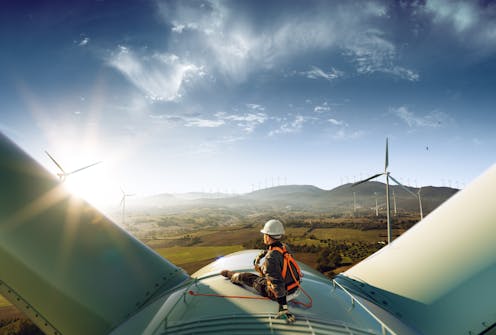To clean up Australia's power grid, we're going to need many thousands more skilled workers – and fast
- Written by Jay Rutovitz, Research Director, Institute for Sustainable Futures, University of Technology Sydney

To get Australia’s grid 82% powered by renewables by 2030 is a huge increase. At present, the electricity powering eastern and southern states is around 33% renewable[1].
To get there means a lot of work. Over the next seven years, it would be equivalent to[2] installing dozens of large wind turbines every month, and tens of thousands of solar panels every day.
And work needs workers. To make this happen, our modelling shows[3] 15,000 more workers are needed by 2025 – less than three years away. That’s amid a skills shortage, an infrastructure boom[4] and unemployment rates at the lowest level in decades.
So how to do it? We need to train more skilled workers and give them more security. Renewable projects have tended to operate on boom-bust cycles when it comes to jobs. But to get where we need to be, we need to shift to a long-term boom mentality. We’re going to need people doing these jobs for decades to come.
How big is this issue?
Big. Getting to 82% renewables and fast means we need to greatly scale up the electricity sector workforce in generation, storage and transmission line construction.
We estimate the current workforce is around 41,000, including 12,000 working in coal and gas power stations or supplying those power stations with fuel. This is only an estimate, as updated figures won’t be available until the federal government delivers its promised energy employment report[5].
Read more: Wind turbines off the coast could help Australia become an energy superpower, research finds[6]
Australia’s energy market operator, AEMO, publishes regularly updated pathways to a clean-energy future. Now we have federal backing for accelerated timelines, the most likely outcome is the so-called “step change scenario[7]”. This scenario envisages nine times more wind and solar by 2050, to boost capacity to 141 gigawatts, and four times more rooftop solar.
Under this scenario, 15,000 more workers must be ready and able to build and operate renewables and storage, or build transmission lines, by 2025.
The problem is, these workers don’t exist at present. Many existing skilled workers are already paid well by major infrastructure projects, such as metro rail projects in Melbourne and Sydney and regional projects such as inland rail. What’s more, unemployment rates are the lowest in decades, and peak demand for labour to build wind and solar projects is set to outstrip the entire current workforce[8] in some regional areas where the renewable projects will be concentrated.
To add to the challenge, skilled workers tend to live in major population centres – but clean energy projects are virtually all in the regions. So the clean energy sector must compete with big infrastructure projects in the cities, which pay more and don’t involve travel. You can see the challenge. If we don’t get this right, the clean energy transition just won’t happen.
The common answer to workforce shortages is to train more workers. But here, too, there are challenges. Our skilled training sector has long been in the doldrums, with demand spread thin across far-flung regions and policy uncertainty leaving many gaps in capacity.
15,000 new skilled workers are just the start
We modelled the workforce[9] needed to achieve three of the AEMO scenarios: the step change, the hydrogen superpower and the slow change. We also modelled an offshore wind scenario, using AEMO’s modified step change “sensitivity” which takes into account Victoria’s ambitious target[10] for offshore wind.
Under the step change scenario, we found the demand for skilled jobs will increase 37,000 from 2023 and peak at 81,000 in 2049.
But if Australia becomes a major exporter of renewable energy in the form of green hydrogen or green ammonia, as backers like iron ore billionaire Twiggy Forrest are hoping[11], that’s a different story. It would require up to twice the workers of the step-change scenario in the 2030s, and up to triple in the 2040s.
That’s a staggering peak demand of 237,000 jobs, with an average demand of 110,000. To get there, we would need 34,000 extra workers within three years.
Where will the jobs be? New South Wales will be the leading state in most scenarios, with a demand for over 20,000 skilled workers annually until 2050 under the step-change scenario. Across NSW, Queensland and Victoria, the job split by technologies is very similar in this scenario: 37% of jobs in solar, 27–30% for wind, and 17–22% in batteries. The pattern is similar in the offshore wind and slow-change scenarios.














